Understanding Case Proceedings and Appeals
VerifiedAdded on 2020/11/23
|12
|3795
|188
Report
AI Summary
This assignment delves into the workings of a legal system, focusing on the procedures followed during case proceedings and the significance of appeals. It examines how precedents set by courts influence decisions and highlights the role of appeals in ensuring fairness and addressing dissatisfaction with court rulings.
Contribute Materials
Your contribution can guide someone’s learning journey. Share your
documents today.
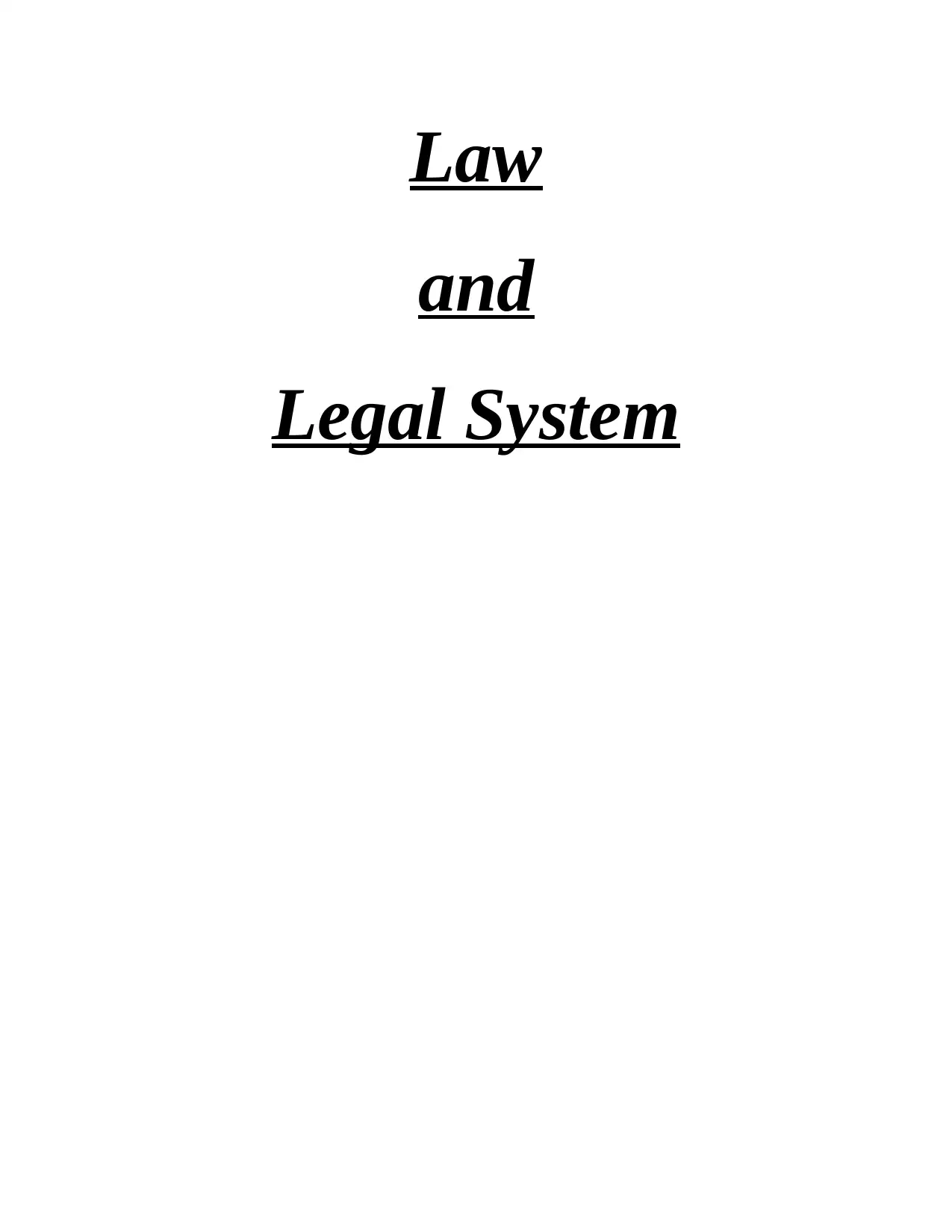
Law
and
Legal System
and
Legal System
Secure Best Marks with AI Grader
Need help grading? Try our AI Grader for instant feedback on your assignments.
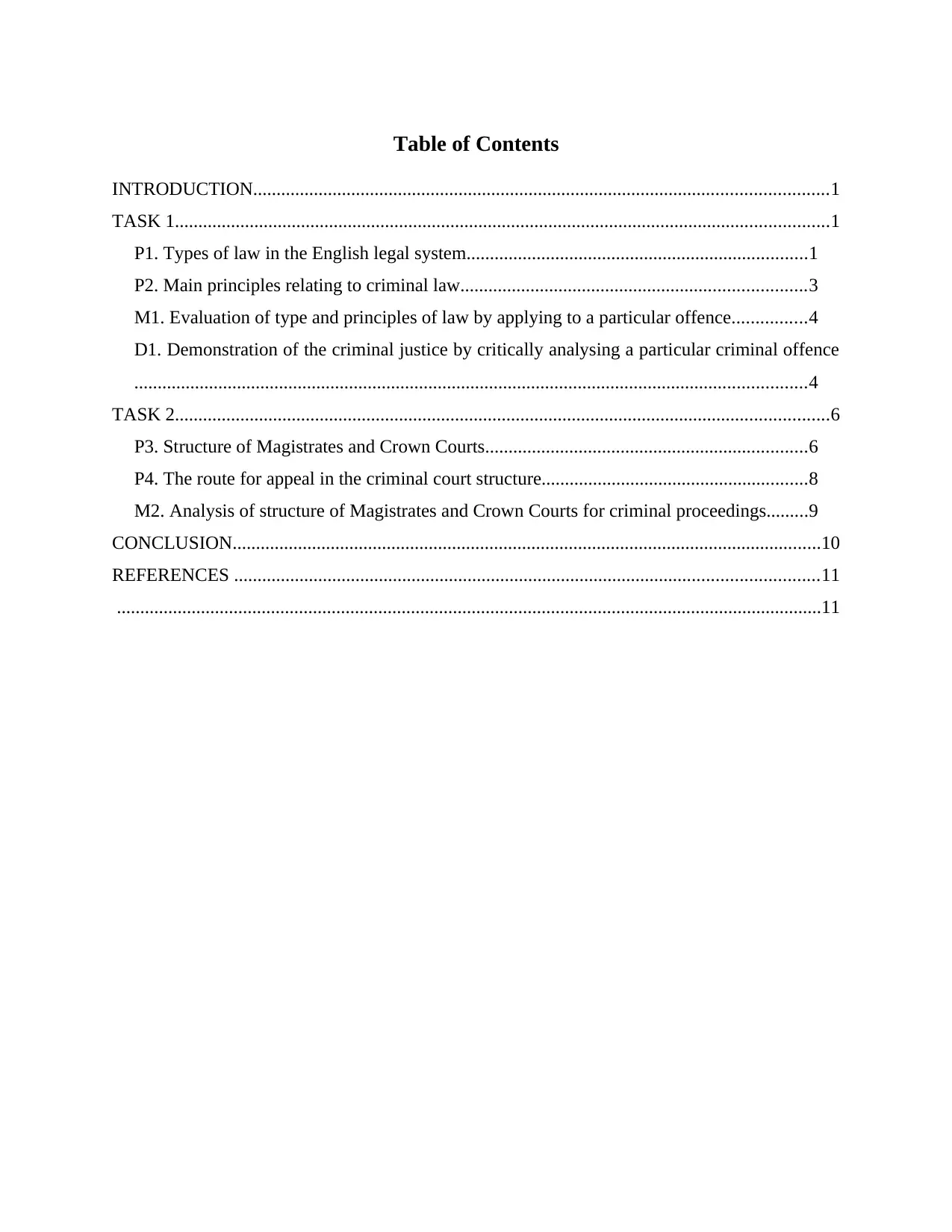
Table of Contents
INTRODUCTION...........................................................................................................................1
TASK 1............................................................................................................................................1
P1. Types of law in the English legal system.........................................................................1
P2. Main principles relating to criminal law..........................................................................3
M1. Evaluation of type and principles of law by applying to a particular offence................4
D1. Demonstration of the criminal justice by critically analysing a particular criminal offence
................................................................................................................................................4
TASK 2............................................................................................................................................6
P3. Structure of Magistrates and Crown Courts.....................................................................6
P4. The route for appeal in the criminal court structure.........................................................8
M2. Analysis of structure of Magistrates and Crown Courts for criminal proceedings.........9
CONCLUSION..............................................................................................................................10
REFERENCES .............................................................................................................................11
.......................................................................................................................................................11
INTRODUCTION...........................................................................................................................1
TASK 1............................................................................................................................................1
P1. Types of law in the English legal system.........................................................................1
P2. Main principles relating to criminal law..........................................................................3
M1. Evaluation of type and principles of law by applying to a particular offence................4
D1. Demonstration of the criminal justice by critically analysing a particular criminal offence
................................................................................................................................................4
TASK 2............................................................................................................................................6
P3. Structure of Magistrates and Crown Courts.....................................................................6
P4. The route for appeal in the criminal court structure.........................................................8
M2. Analysis of structure of Magistrates and Crown Courts for criminal proceedings.........9
CONCLUSION..............................................................................................................................10
REFERENCES .............................................................................................................................11
.......................................................................................................................................................11
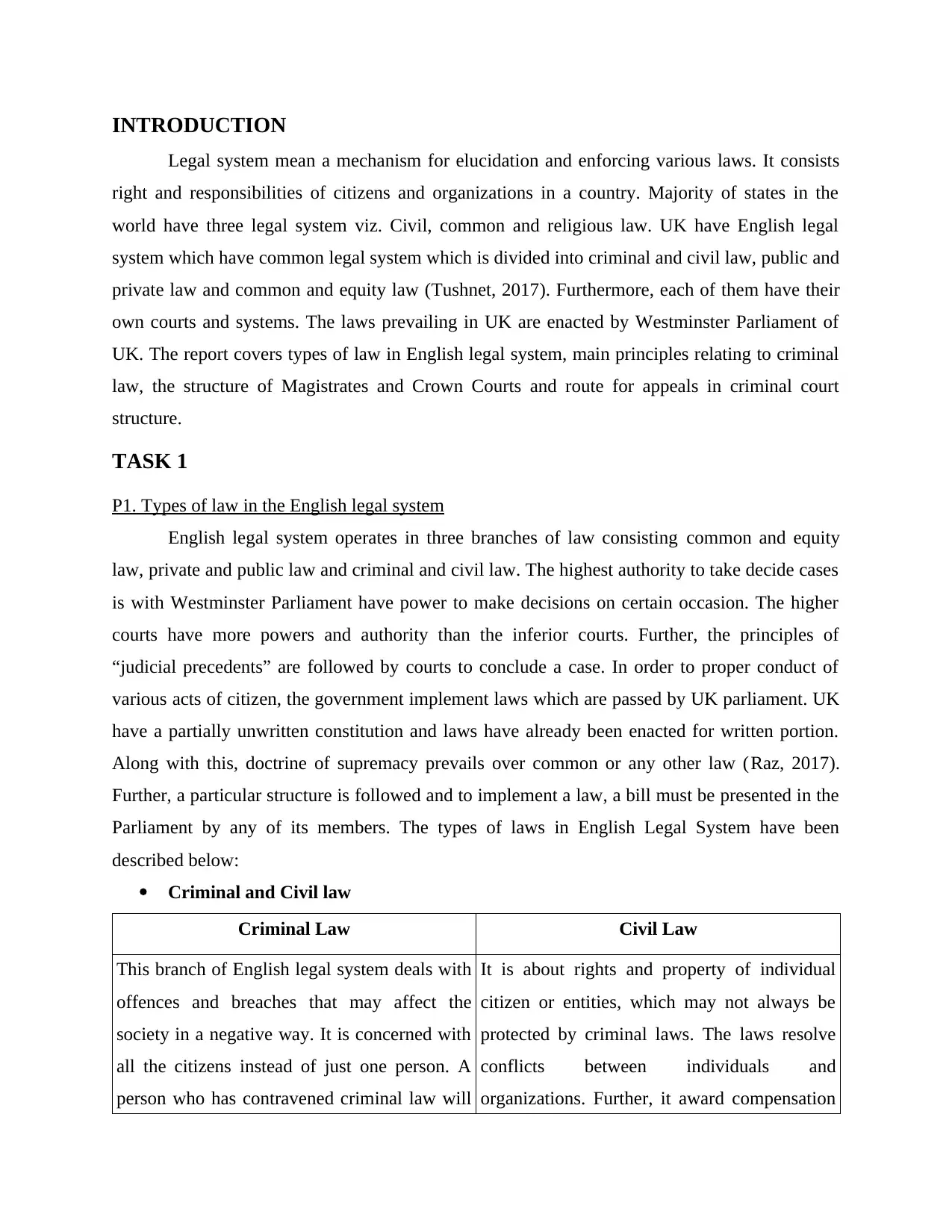
INTRODUCTION
Legal system mean a mechanism for elucidation and enforcing various laws. It consists
right and responsibilities of citizens and organizations in a country. Majority of states in the
world have three legal system viz. Civil, common and religious law. UK have English legal
system which have common legal system which is divided into criminal and civil law, public and
private law and common and equity law (Tushnet, 2017). Furthermore, each of them have their
own courts and systems. The laws prevailing in UK are enacted by Westminster Parliament of
UK. The report covers types of law in English legal system, main principles relating to criminal
law, the structure of Magistrates and Crown Courts and route for appeals in criminal court
structure.
TASK 1
P1. Types of law in the English legal system
English legal system operates in three branches of law consisting common and equity
law, private and public law and criminal and civil law. The highest authority to take decide cases
is with Westminster Parliament have power to make decisions on certain occasion. The higher
courts have more powers and authority than the inferior courts. Further, the principles of
“judicial precedents” are followed by courts to conclude a case. In order to proper conduct of
various acts of citizen, the government implement laws which are passed by UK parliament. UK
have a partially unwritten constitution and laws have already been enacted for written portion.
Along with this, doctrine of supremacy prevails over common or any other law (Raz, 2017).
Further, a particular structure is followed and to implement a law, a bill must be presented in the
Parliament by any of its members. The types of laws in English Legal System have been
described below:
Criminal and Civil law
Criminal Law Civil Law
This branch of English legal system deals with
offences and breaches that may affect the
society in a negative way. It is concerned with
all the citizens instead of just one person. A
person who has contravened criminal law will
It is about rights and property of individual
citizen or entities, which may not always be
protected by criminal laws. The laws resolve
conflicts between individuals and
organizations. Further, it award compensation
Legal system mean a mechanism for elucidation and enforcing various laws. It consists
right and responsibilities of citizens and organizations in a country. Majority of states in the
world have three legal system viz. Civil, common and religious law. UK have English legal
system which have common legal system which is divided into criminal and civil law, public and
private law and common and equity law (Tushnet, 2017). Furthermore, each of them have their
own courts and systems. The laws prevailing in UK are enacted by Westminster Parliament of
UK. The report covers types of law in English legal system, main principles relating to criminal
law, the structure of Magistrates and Crown Courts and route for appeals in criminal court
structure.
TASK 1
P1. Types of law in the English legal system
English legal system operates in three branches of law consisting common and equity
law, private and public law and criminal and civil law. The highest authority to take decide cases
is with Westminster Parliament have power to make decisions on certain occasion. The higher
courts have more powers and authority than the inferior courts. Further, the principles of
“judicial precedents” are followed by courts to conclude a case. In order to proper conduct of
various acts of citizen, the government implement laws which are passed by UK parliament. UK
have a partially unwritten constitution and laws have already been enacted for written portion.
Along with this, doctrine of supremacy prevails over common or any other law (Raz, 2017).
Further, a particular structure is followed and to implement a law, a bill must be presented in the
Parliament by any of its members. The types of laws in English Legal System have been
described below:
Criminal and Civil law
Criminal Law Civil Law
This branch of English legal system deals with
offences and breaches that may affect the
society in a negative way. It is concerned with
all the citizens instead of just one person. A
person who has contravened criminal law will
It is about rights and property of individual
citizen or entities, which may not always be
protected by criminal laws. The laws resolve
conflicts between individuals and
organizations. Further, it award compensation
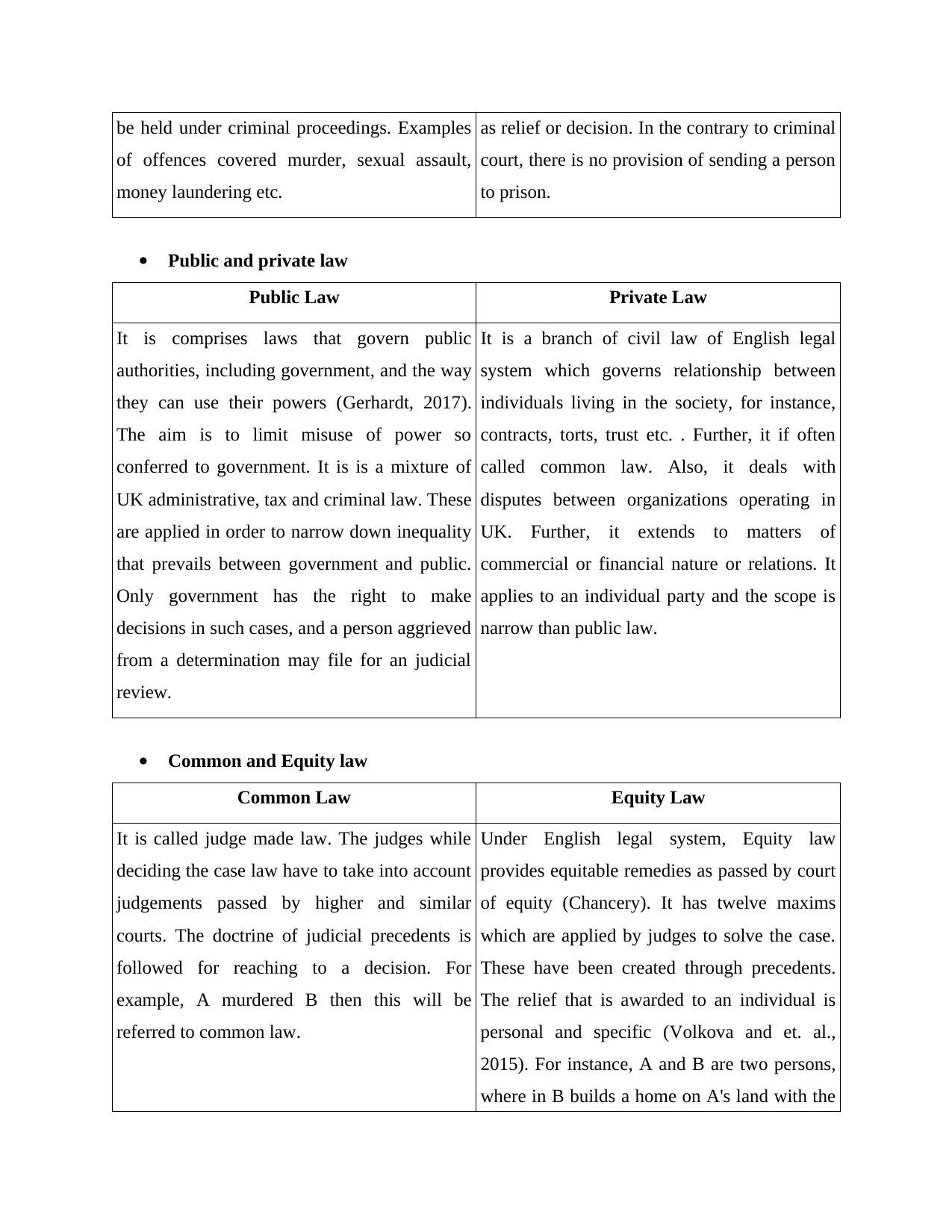
be held under criminal proceedings. Examples
of offences covered murder, sexual assault,
money laundering etc.
as relief or decision. In the contrary to criminal
court, there is no provision of sending a person
to prison.
Public and private law
Public Law Private Law
It is comprises laws that govern public
authorities, including government, and the way
they can use their powers (Gerhardt, 2017).
The aim is to limit misuse of power so
conferred to government. It is is a mixture of
UK administrative, tax and criminal law. These
are applied in order to narrow down inequality
that prevails between government and public.
Only government has the right to make
decisions in such cases, and a person aggrieved
from a determination may file for an judicial
review.
It is a branch of civil law of English legal
system which governs relationship between
individuals living in the society, for instance,
contracts, torts, trust etc. . Further, it if often
called common law. Also, it deals with
disputes between organizations operating in
UK. Further, it extends to matters of
commercial or financial nature or relations. It
applies to an individual party and the scope is
narrow than public law.
Common and Equity law
Common Law Equity Law
It is called judge made law. The judges while
deciding the case law have to take into account
judgements passed by higher and similar
courts. The doctrine of judicial precedents is
followed for reaching to a decision. For
example, A murdered B then this will be
referred to common law.
Under English legal system, Equity law
provides equitable remedies as passed by court
of equity (Chancery). It has twelve maxims
which are applied by judges to solve the case.
These have been created through precedents.
The relief that is awarded to an individual is
personal and specific (Volkova and et. al.,
2015). For instance, A and B are two persons,
where in B builds a home on A's land with the
of offences covered murder, sexual assault,
money laundering etc.
as relief or decision. In the contrary to criminal
court, there is no provision of sending a person
to prison.
Public and private law
Public Law Private Law
It is comprises laws that govern public
authorities, including government, and the way
they can use their powers (Gerhardt, 2017).
The aim is to limit misuse of power so
conferred to government. It is is a mixture of
UK administrative, tax and criminal law. These
are applied in order to narrow down inequality
that prevails between government and public.
Only government has the right to make
decisions in such cases, and a person aggrieved
from a determination may file for an judicial
review.
It is a branch of civil law of English legal
system which governs relationship between
individuals living in the society, for instance,
contracts, torts, trust etc. . Further, it if often
called common law. Also, it deals with
disputes between organizations operating in
UK. Further, it extends to matters of
commercial or financial nature or relations. It
applies to an individual party and the scope is
narrow than public law.
Common and Equity law
Common Law Equity Law
It is called judge made law. The judges while
deciding the case law have to take into account
judgements passed by higher and similar
courts. The doctrine of judicial precedents is
followed for reaching to a decision. For
example, A murdered B then this will be
referred to common law.
Under English legal system, Equity law
provides equitable remedies as passed by court
of equity (Chancery). It has twelve maxims
which are applied by judges to solve the case.
These have been created through precedents.
The relief that is awarded to an individual is
personal and specific (Volkova and et. al.,
2015). For instance, A and B are two persons,
where in B builds a home on A's land with the
Secure Best Marks with AI Grader
Need help grading? Try our AI Grader for instant feedback on your assignments.
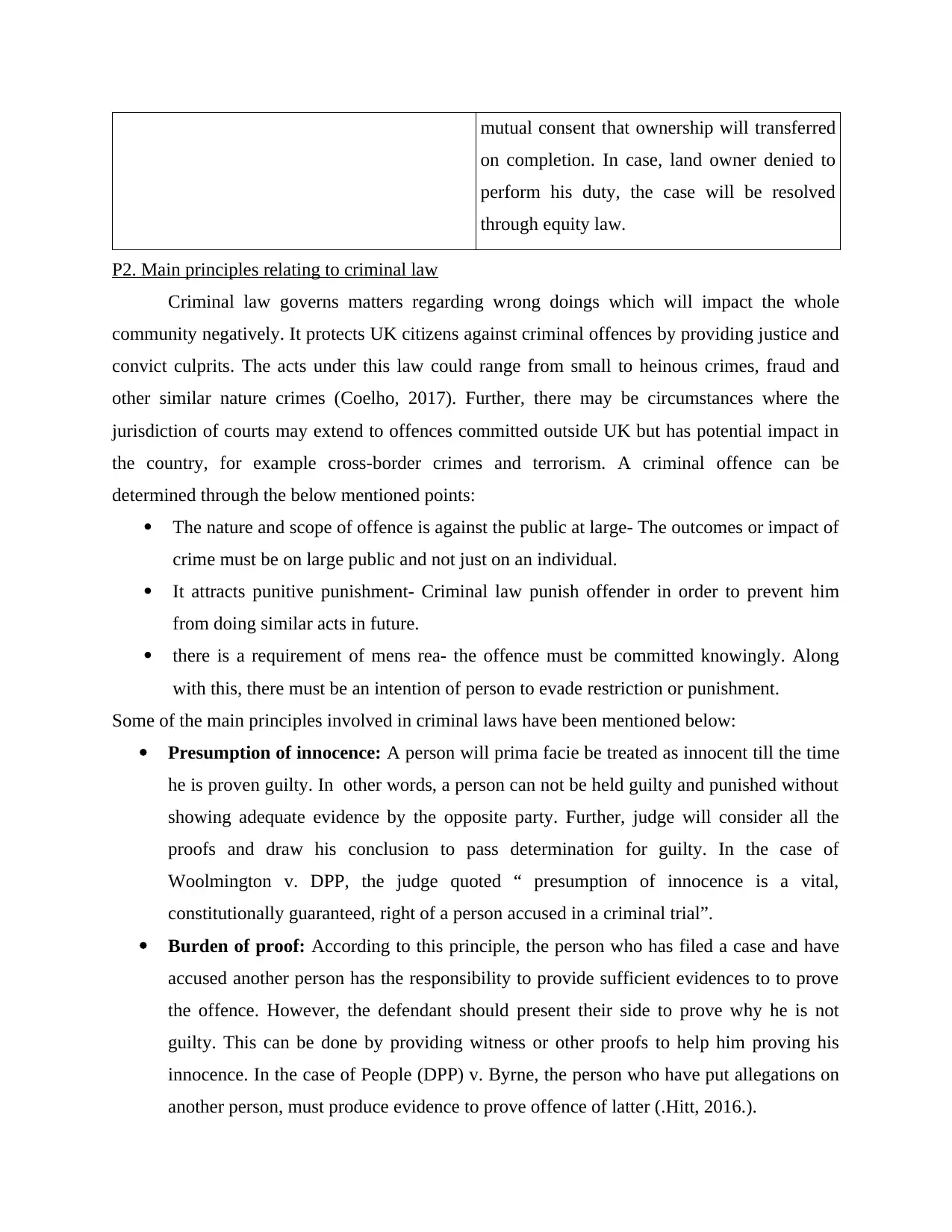
mutual consent that ownership will transferred
on completion. In case, land owner denied to
perform his duty, the case will be resolved
through equity law.
P2. Main principles relating to criminal law
Criminal law governs matters regarding wrong doings which will impact the whole
community negatively. It protects UK citizens against criminal offences by providing justice and
convict culprits. The acts under this law could range from small to heinous crimes, fraud and
other similar nature crimes (Coelho, 2017). Further, there may be circumstances where the
jurisdiction of courts may extend to offences committed outside UK but has potential impact in
the country, for example cross-border crimes and terrorism. A criminal offence can be
determined through the below mentioned points:
The nature and scope of offence is against the public at large- The outcomes or impact of
crime must be on large public and not just on an individual.
It attracts punitive punishment- Criminal law punish offender in order to prevent him
from doing similar acts in future.
there is a requirement of mens rea- the offence must be committed knowingly. Along
with this, there must be an intention of person to evade restriction or punishment.
Some of the main principles involved in criminal laws have been mentioned below:
Presumption of innocence: A person will prima facie be treated as innocent till the time
he is proven guilty. In other words, a person can not be held guilty and punished without
showing adequate evidence by the opposite party. Further, judge will consider all the
proofs and draw his conclusion to pass determination for guilty. In the case of
Woolmington v. DPP, the judge quoted “ presumption of innocence is a vital,
constitutionally guaranteed, right of a person accused in a criminal trial”.
Burden of proof: According to this principle, the person who has filed a case and have
accused another person has the responsibility to provide sufficient evidences to to prove
the offence. However, the defendant should present their side to prove why he is not
guilty. This can be done by providing witness or other proofs to help him proving his
innocence. In the case of People (DPP) v. Byrne, the person who have put allegations on
another person, must produce evidence to prove offence of latter (.Hitt, 2016.).
on completion. In case, land owner denied to
perform his duty, the case will be resolved
through equity law.
P2. Main principles relating to criminal law
Criminal law governs matters regarding wrong doings which will impact the whole
community negatively. It protects UK citizens against criminal offences by providing justice and
convict culprits. The acts under this law could range from small to heinous crimes, fraud and
other similar nature crimes (Coelho, 2017). Further, there may be circumstances where the
jurisdiction of courts may extend to offences committed outside UK but has potential impact in
the country, for example cross-border crimes and terrorism. A criminal offence can be
determined through the below mentioned points:
The nature and scope of offence is against the public at large- The outcomes or impact of
crime must be on large public and not just on an individual.
It attracts punitive punishment- Criminal law punish offender in order to prevent him
from doing similar acts in future.
there is a requirement of mens rea- the offence must be committed knowingly. Along
with this, there must be an intention of person to evade restriction or punishment.
Some of the main principles involved in criminal laws have been mentioned below:
Presumption of innocence: A person will prima facie be treated as innocent till the time
he is proven guilty. In other words, a person can not be held guilty and punished without
showing adequate evidence by the opposite party. Further, judge will consider all the
proofs and draw his conclusion to pass determination for guilty. In the case of
Woolmington v. DPP, the judge quoted “ presumption of innocence is a vital,
constitutionally guaranteed, right of a person accused in a criminal trial”.
Burden of proof: According to this principle, the person who has filed a case and have
accused another person has the responsibility to provide sufficient evidences to to prove
the offence. However, the defendant should present their side to prove why he is not
guilty. This can be done by providing witness or other proofs to help him proving his
innocence. In the case of People (DPP) v. Byrne, the person who have put allegations on
another person, must produce evidence to prove offence of latter (.Hitt, 2016.).
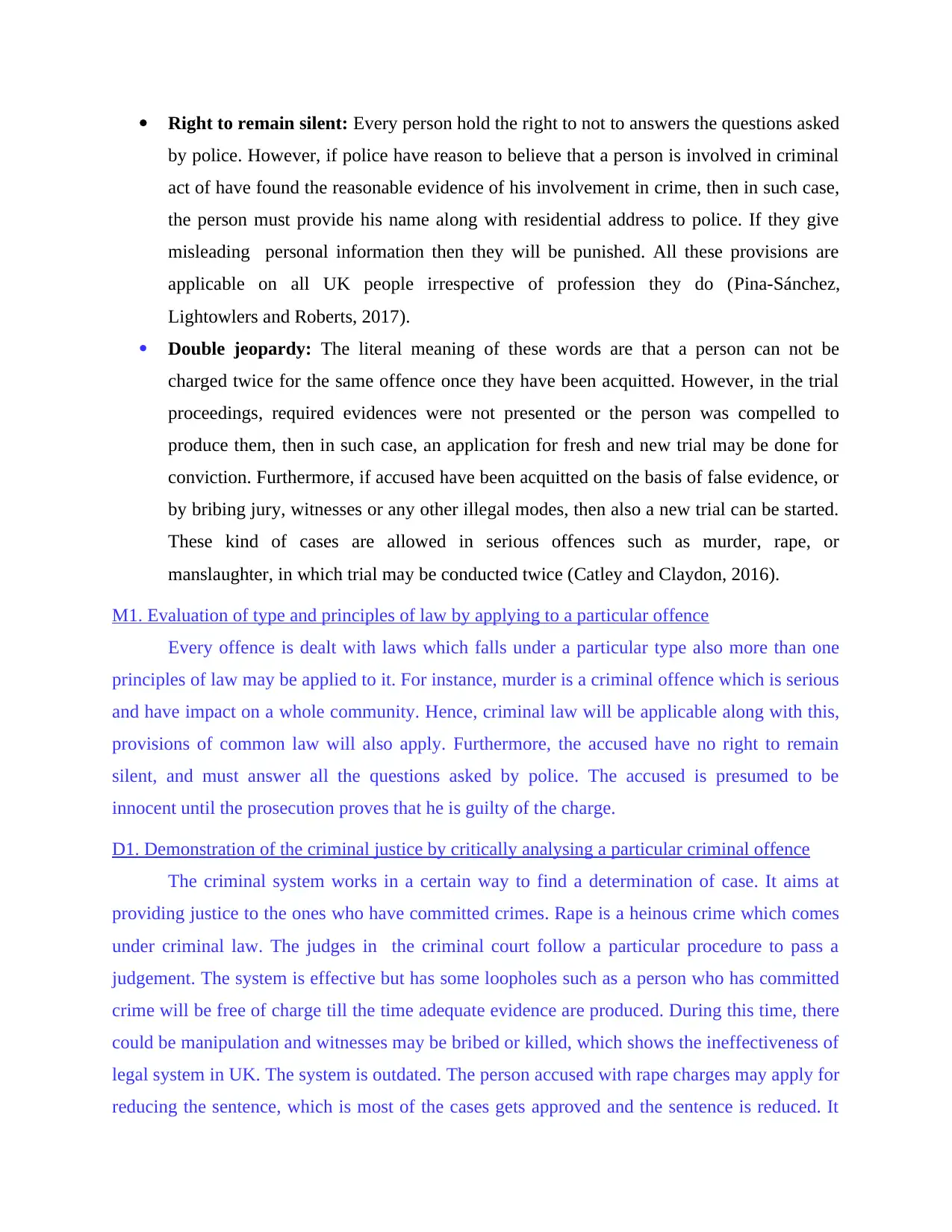
Right to remain silent: Every person hold the right to not to answers the questions asked
by police. However, if police have reason to believe that a person is involved in criminal
act of have found the reasonable evidence of his involvement in crime, then in such case,
the person must provide his name along with residential address to police. If they give
misleading personal information then they will be punished. All these provisions are
applicable on all UK people irrespective of profession they do (Pina-Sánchez,
Lightowlers and Roberts, 2017).
Double jeopardy: The literal meaning of these words are that a person can not be
charged twice for the same offence once they have been acquitted. However, in the trial
proceedings, required evidences were not presented or the person was compelled to
produce them, then in such case, an application for fresh and new trial may be done for
conviction. Furthermore, if accused have been acquitted on the basis of false evidence, or
by bribing jury, witnesses or any other illegal modes, then also a new trial can be started.
These kind of cases are allowed in serious offences such as murder, rape, or
manslaughter, in which trial may be conducted twice (Catley and Claydon, 2016).
M1. Evaluation of type and principles of law by applying to a particular offence
Every offence is dealt with laws which falls under a particular type also more than one
principles of law may be applied to it. For instance, murder is a criminal offence which is serious
and have impact on a whole community. Hence, criminal law will be applicable along with this,
provisions of common law will also apply. Furthermore, the accused have no right to remain
silent, and must answer all the questions asked by police. The accused is presumed to be
innocent until the prosecution proves that he is guilty of the charge.
D1. Demonstration of the criminal justice by critically analysing a particular criminal offence
The criminal system works in a certain way to find a determination of case. It aims at
providing justice to the ones who have committed crimes. Rape is a heinous crime which comes
under criminal law. The judges in the criminal court follow a particular procedure to pass a
judgement. The system is effective but has some loopholes such as a person who has committed
crime will be free of charge till the time adequate evidence are produced. During this time, there
could be manipulation and witnesses may be bribed or killed, which shows the ineffectiveness of
legal system in UK. The system is outdated. The person accused with rape charges may apply for
reducing the sentence, which is most of the cases gets approved and the sentence is reduced. It
by police. However, if police have reason to believe that a person is involved in criminal
act of have found the reasonable evidence of his involvement in crime, then in such case,
the person must provide his name along with residential address to police. If they give
misleading personal information then they will be punished. All these provisions are
applicable on all UK people irrespective of profession they do (Pina-Sánchez,
Lightowlers and Roberts, 2017).
Double jeopardy: The literal meaning of these words are that a person can not be
charged twice for the same offence once they have been acquitted. However, in the trial
proceedings, required evidences were not presented or the person was compelled to
produce them, then in such case, an application for fresh and new trial may be done for
conviction. Furthermore, if accused have been acquitted on the basis of false evidence, or
by bribing jury, witnesses or any other illegal modes, then also a new trial can be started.
These kind of cases are allowed in serious offences such as murder, rape, or
manslaughter, in which trial may be conducted twice (Catley and Claydon, 2016).
M1. Evaluation of type and principles of law by applying to a particular offence
Every offence is dealt with laws which falls under a particular type also more than one
principles of law may be applied to it. For instance, murder is a criminal offence which is serious
and have impact on a whole community. Hence, criminal law will be applicable along with this,
provisions of common law will also apply. Furthermore, the accused have no right to remain
silent, and must answer all the questions asked by police. The accused is presumed to be
innocent until the prosecution proves that he is guilty of the charge.
D1. Demonstration of the criminal justice by critically analysing a particular criminal offence
The criminal system works in a certain way to find a determination of case. It aims at
providing justice to the ones who have committed crimes. Rape is a heinous crime which comes
under criminal law. The judges in the criminal court follow a particular procedure to pass a
judgement. The system is effective but has some loopholes such as a person who has committed
crime will be free of charge till the time adequate evidence are produced. During this time, there
could be manipulation and witnesses may be bribed or killed, which shows the ineffectiveness of
legal system in UK. The system is outdated. The person accused with rape charges may apply for
reducing the sentence, which is most of the cases gets approved and the sentence is reduced. It
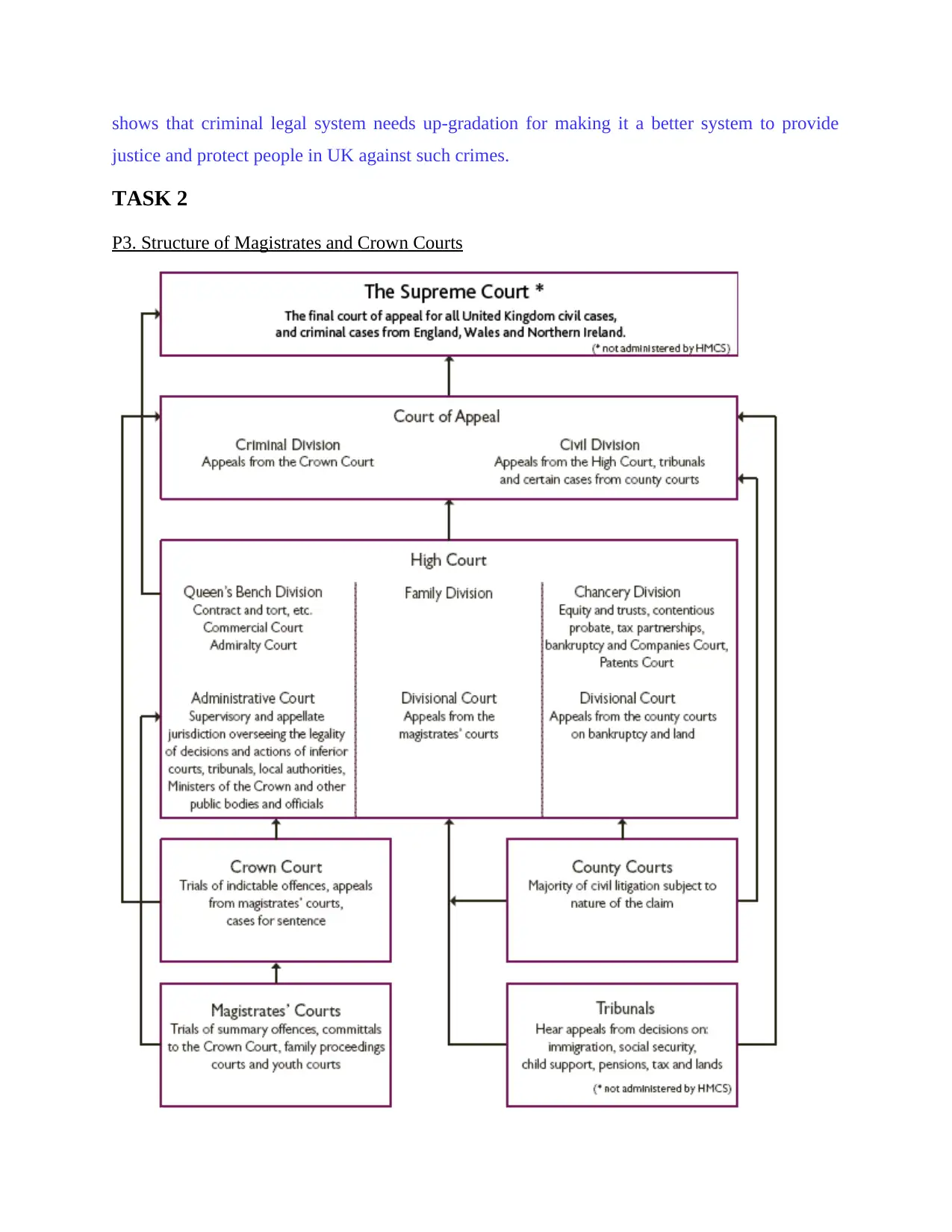
shows that criminal legal system needs up-gradation for making it a better system to provide
justice and protect people in UK against such crimes.
TASK 2
P3. Structure of Magistrates and Crown Courts
justice and protect people in UK against such crimes.
TASK 2
P3. Structure of Magistrates and Crown Courts
Paraphrase This Document
Need a fresh take? Get an instant paraphrase of this document with our AI Paraphraser
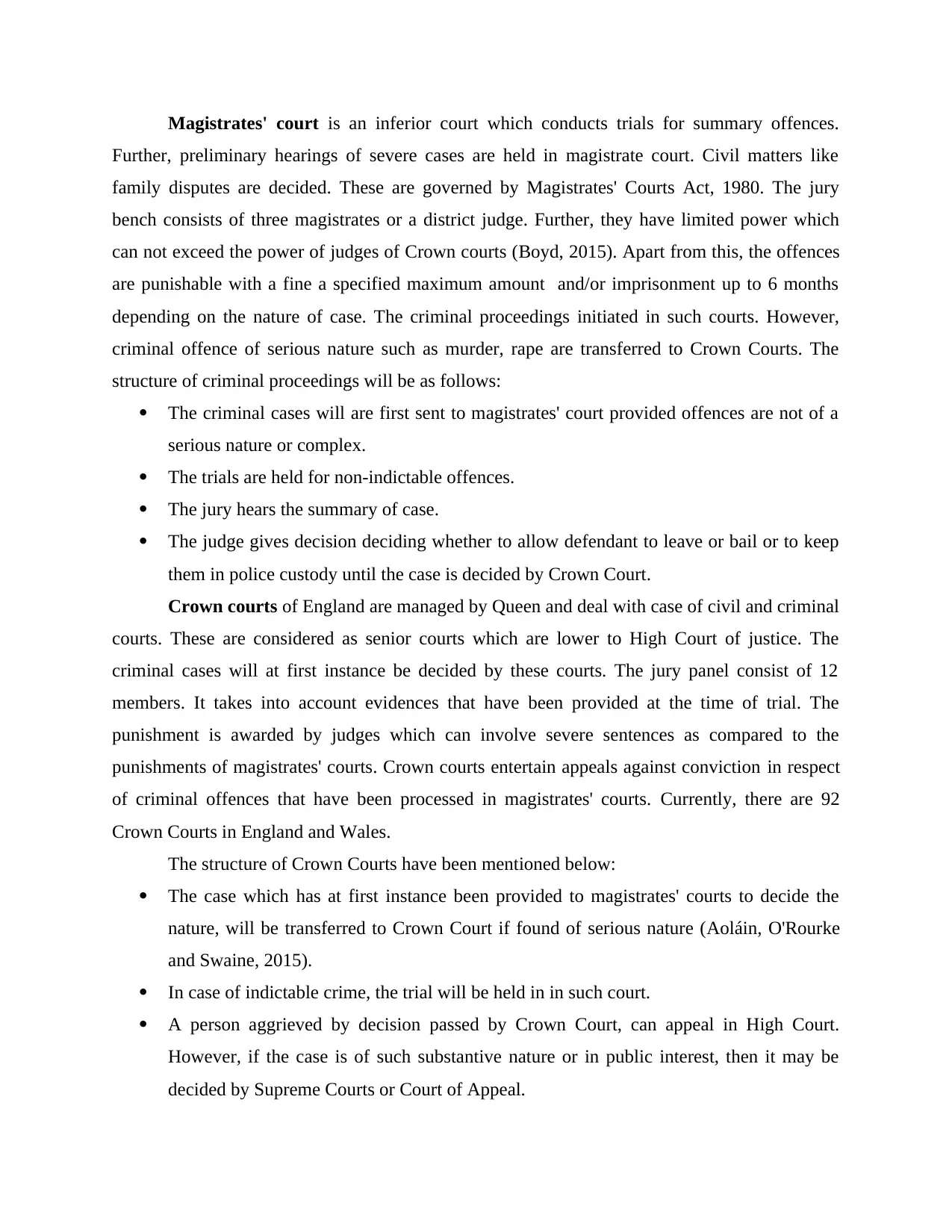
Magistrates' court is an inferior court which conducts trials for summary offences.
Further, preliminary hearings of severe cases are held in magistrate court. Civil matters like
family disputes are decided. These are governed by Magistrates' Courts Act, 1980. The jury
bench consists of three magistrates or a district judge. Further, they have limited power which
can not exceed the power of judges of Crown courts (Boyd, 2015). Apart from this, the offences
are punishable with a fine a specified maximum amount and/or imprisonment up to 6 months
depending on the nature of case. The criminal proceedings initiated in such courts. However,
criminal offence of serious nature such as murder, rape are transferred to Crown Courts. The
structure of criminal proceedings will be as follows:
The criminal cases will are first sent to magistrates' court provided offences are not of a
serious nature or complex.
The trials are held for non-indictable offences.
The jury hears the summary of case.
The judge gives decision deciding whether to allow defendant to leave or bail or to keep
them in police custody until the case is decided by Crown Court.
Crown courts of England are managed by Queen and deal with case of civil and criminal
courts. These are considered as senior courts which are lower to High Court of justice. The
criminal cases will at first instance be decided by these courts. The jury panel consist of 12
members. It takes into account evidences that have been provided at the time of trial. The
punishment is awarded by judges which can involve severe sentences as compared to the
punishments of magistrates' courts. Crown courts entertain appeals against conviction in respect
of criminal offences that have been processed in magistrates' courts. Currently, there are 92
Crown Courts in England and Wales.
The structure of Crown Courts have been mentioned below:
The case which has at first instance been provided to magistrates' courts to decide the
nature, will be transferred to Crown Court if found of serious nature (Aoláin, O'Rourke
and Swaine, 2015).
In case of indictable crime, the trial will be held in in such court.
A person aggrieved by decision passed by Crown Court, can appeal in High Court.
However, if the case is of such substantive nature or in public interest, then it may be
decided by Supreme Courts or Court of Appeal.
Further, preliminary hearings of severe cases are held in magistrate court. Civil matters like
family disputes are decided. These are governed by Magistrates' Courts Act, 1980. The jury
bench consists of three magistrates or a district judge. Further, they have limited power which
can not exceed the power of judges of Crown courts (Boyd, 2015). Apart from this, the offences
are punishable with a fine a specified maximum amount and/or imprisonment up to 6 months
depending on the nature of case. The criminal proceedings initiated in such courts. However,
criminal offence of serious nature such as murder, rape are transferred to Crown Courts. The
structure of criminal proceedings will be as follows:
The criminal cases will are first sent to magistrates' court provided offences are not of a
serious nature or complex.
The trials are held for non-indictable offences.
The jury hears the summary of case.
The judge gives decision deciding whether to allow defendant to leave or bail or to keep
them in police custody until the case is decided by Crown Court.
Crown courts of England are managed by Queen and deal with case of civil and criminal
courts. These are considered as senior courts which are lower to High Court of justice. The
criminal cases will at first instance be decided by these courts. The jury panel consist of 12
members. It takes into account evidences that have been provided at the time of trial. The
punishment is awarded by judges which can involve severe sentences as compared to the
punishments of magistrates' courts. Crown courts entertain appeals against conviction in respect
of criminal offences that have been processed in magistrates' courts. Currently, there are 92
Crown Courts in England and Wales.
The structure of Crown Courts have been mentioned below:
The case which has at first instance been provided to magistrates' courts to decide the
nature, will be transferred to Crown Court if found of serious nature (Aoláin, O'Rourke
and Swaine, 2015).
In case of indictable crime, the trial will be held in in such court.
A person aggrieved by decision passed by Crown Court, can appeal in High Court.
However, if the case is of such substantive nature or in public interest, then it may be
decided by Supreme Courts or Court of Appeal.
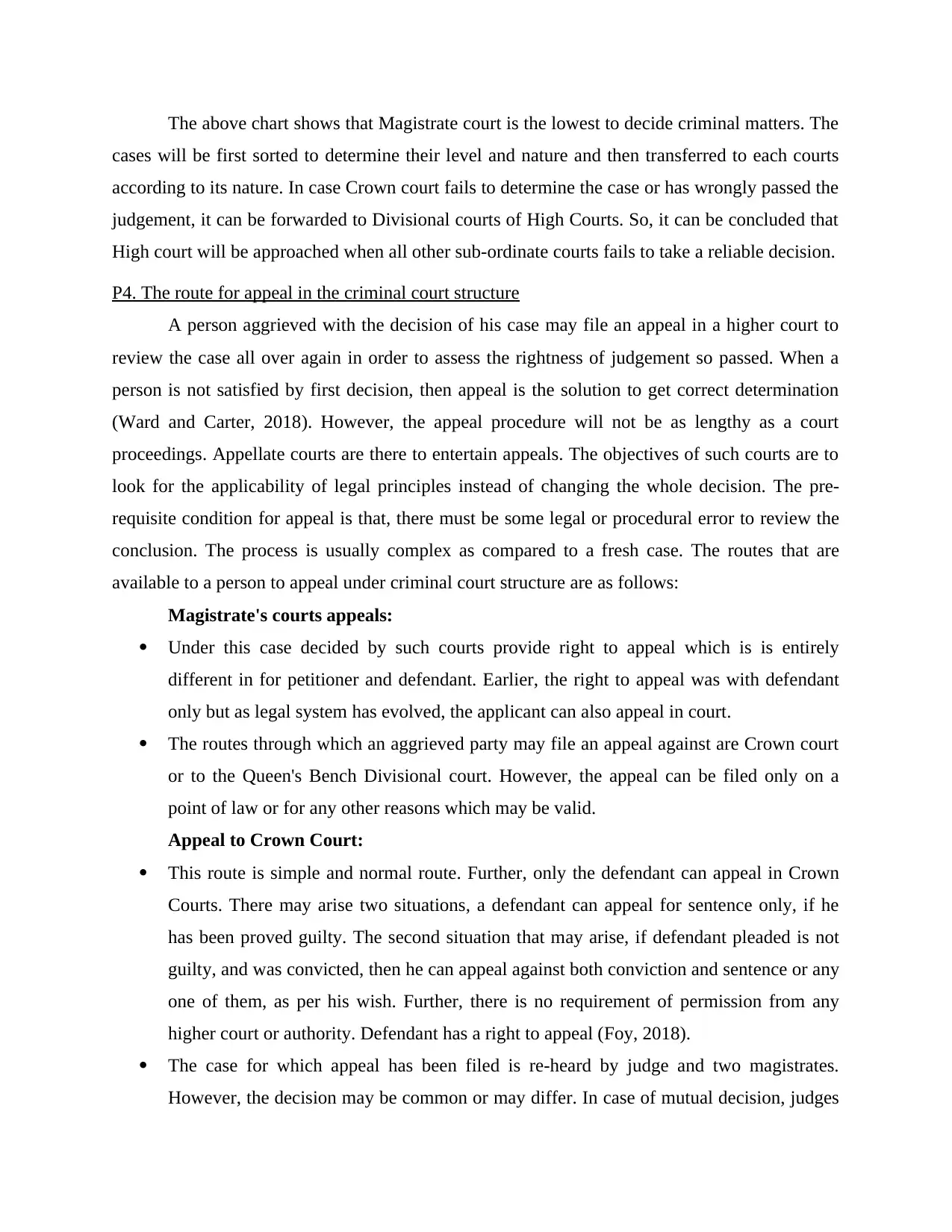
The above chart shows that Magistrate court is the lowest to decide criminal matters. The
cases will be first sorted to determine their level and nature and then transferred to each courts
according to its nature. In case Crown court fails to determine the case or has wrongly passed the
judgement, it can be forwarded to Divisional courts of High Courts. So, it can be concluded that
High court will be approached when all other sub-ordinate courts fails to take a reliable decision.
P4. The route for appeal in the criminal court structure
A person aggrieved with the decision of his case may file an appeal in a higher court to
review the case all over again in order to assess the rightness of judgement so passed. When a
person is not satisfied by first decision, then appeal is the solution to get correct determination
(Ward and Carter, 2018). However, the appeal procedure will not be as lengthy as a court
proceedings. Appellate courts are there to entertain appeals. The objectives of such courts are to
look for the applicability of legal principles instead of changing the whole decision. The pre-
requisite condition for appeal is that, there must be some legal or procedural error to review the
conclusion. The process is usually complex as compared to a fresh case. The routes that are
available to a person to appeal under criminal court structure are as follows:
Magistrate's courts appeals:
Under this case decided by such courts provide right to appeal which is is entirely
different in for petitioner and defendant. Earlier, the right to appeal was with defendant
only but as legal system has evolved, the applicant can also appeal in court.
The routes through which an aggrieved party may file an appeal against are Crown court
or to the Queen's Bench Divisional court. However, the appeal can be filed only on a
point of law or for any other reasons which may be valid.
Appeal to Crown Court:
This route is simple and normal route. Further, only the defendant can appeal in Crown
Courts. There may arise two situations, a defendant can appeal for sentence only, if he
has been proved guilty. The second situation that may arise, if defendant pleaded is not
guilty, and was convicted, then he can appeal against both conviction and sentence or any
one of them, as per his wish. Further, there is no requirement of permission from any
higher court or authority. Defendant has a right to appeal (Foy, 2018).
The case for which appeal has been filed is re-heard by judge and two magistrates.
However, the decision may be common or may differ. In case of mutual decision, judges
cases will be first sorted to determine their level and nature and then transferred to each courts
according to its nature. In case Crown court fails to determine the case or has wrongly passed the
judgement, it can be forwarded to Divisional courts of High Courts. So, it can be concluded that
High court will be approached when all other sub-ordinate courts fails to take a reliable decision.
P4. The route for appeal in the criminal court structure
A person aggrieved with the decision of his case may file an appeal in a higher court to
review the case all over again in order to assess the rightness of judgement so passed. When a
person is not satisfied by first decision, then appeal is the solution to get correct determination
(Ward and Carter, 2018). However, the appeal procedure will not be as lengthy as a court
proceedings. Appellate courts are there to entertain appeals. The objectives of such courts are to
look for the applicability of legal principles instead of changing the whole decision. The pre-
requisite condition for appeal is that, there must be some legal or procedural error to review the
conclusion. The process is usually complex as compared to a fresh case. The routes that are
available to a person to appeal under criminal court structure are as follows:
Magistrate's courts appeals:
Under this case decided by such courts provide right to appeal which is is entirely
different in for petitioner and defendant. Earlier, the right to appeal was with defendant
only but as legal system has evolved, the applicant can also appeal in court.
The routes through which an aggrieved party may file an appeal against are Crown court
or to the Queen's Bench Divisional court. However, the appeal can be filed only on a
point of law or for any other reasons which may be valid.
Appeal to Crown Court:
This route is simple and normal route. Further, only the defendant can appeal in Crown
Courts. There may arise two situations, a defendant can appeal for sentence only, if he
has been proved guilty. The second situation that may arise, if defendant pleaded is not
guilty, and was convicted, then he can appeal against both conviction and sentence or any
one of them, as per his wish. Further, there is no requirement of permission from any
higher court or authority. Defendant has a right to appeal (Foy, 2018).
The case for which appeal has been filed is re-heard by judge and two magistrates.
However, the decision may be common or may differ. In case of mutual decision, judges

can confirm conviction. On the contrary, if decision differs, the decision may be reverse
on case not being proved. Furthermore, there are some cases where they have limited
powers, thus, can not change the first decision or reduce the sentence (Mitchell and
Stockdale, 2018).
In case, appeal is against sentence, the jury of Crown court can confirm sentence, also
they can make changes in it. In other words, it can be increased or decreased. Provided,
the extension in sentence can not exceed magistrate's maximum power for the lawsuit.
The procedure that is followed in appeal under criminal court is as follows:
▪ Magistrate's court: A summary trial is conducted before 3 magistrates or a
district judge.
▪ Defendant can file an appeal against conviction he has not been guilty and against
sentence.
▪ Appeal against a conviction, the whole case will be re-heard from the beginning
as a fresh case.
▪ The right to appeal has been given to both prosecution or defendant through case
stated, if according to their judgement, decision was wrong or beyond jurisdiction
of court.
▪ The appeal is then heard by minimum of 2 judges, they hear the matter and may
affirm, reverse or amend the decision for which appeal has been filed.
▪ In case, the matter is of substantive nature or in public interest, it may be
forwarded to House of Lords. The panel constitutes 5 to 7 Lords of Appeal in
ordinary. They have same power as of Court of Appeal.
M2. Analysis of structure of Magistrates and Crown Courts for criminal proceedings
The legal system of criminal offences that Magistrates' courts and Crown Courts are
complex and it is not easy to understand the systems. Along with this, the process is also time
consuming which may take several months to pass a judgement in a case. Furthermore, criminal
offences requires specific and valid evidence to prove the case. Even the appeal procedure is also
lengthy and tricky to understand. There is a need to amend it, in order to remove the loopholes
such as easily getting the reduced sentence for the offence.
on case not being proved. Furthermore, there are some cases where they have limited
powers, thus, can not change the first decision or reduce the sentence (Mitchell and
Stockdale, 2018).
In case, appeal is against sentence, the jury of Crown court can confirm sentence, also
they can make changes in it. In other words, it can be increased or decreased. Provided,
the extension in sentence can not exceed magistrate's maximum power for the lawsuit.
The procedure that is followed in appeal under criminal court is as follows:
▪ Magistrate's court: A summary trial is conducted before 3 magistrates or a
district judge.
▪ Defendant can file an appeal against conviction he has not been guilty and against
sentence.
▪ Appeal against a conviction, the whole case will be re-heard from the beginning
as a fresh case.
▪ The right to appeal has been given to both prosecution or defendant through case
stated, if according to their judgement, decision was wrong or beyond jurisdiction
of court.
▪ The appeal is then heard by minimum of 2 judges, they hear the matter and may
affirm, reverse or amend the decision for which appeal has been filed.
▪ In case, the matter is of substantive nature or in public interest, it may be
forwarded to House of Lords. The panel constitutes 5 to 7 Lords of Appeal in
ordinary. They have same power as of Court of Appeal.
M2. Analysis of structure of Magistrates and Crown Courts for criminal proceedings
The legal system of criminal offences that Magistrates' courts and Crown Courts are
complex and it is not easy to understand the systems. Along with this, the process is also time
consuming which may take several months to pass a judgement in a case. Furthermore, criminal
offences requires specific and valid evidence to prove the case. Even the appeal procedure is also
lengthy and tricky to understand. There is a need to amend it, in order to remove the loopholes
such as easily getting the reduced sentence for the offence.
Secure Best Marks with AI Grader
Need help grading? Try our AI Grader for instant feedback on your assignments.
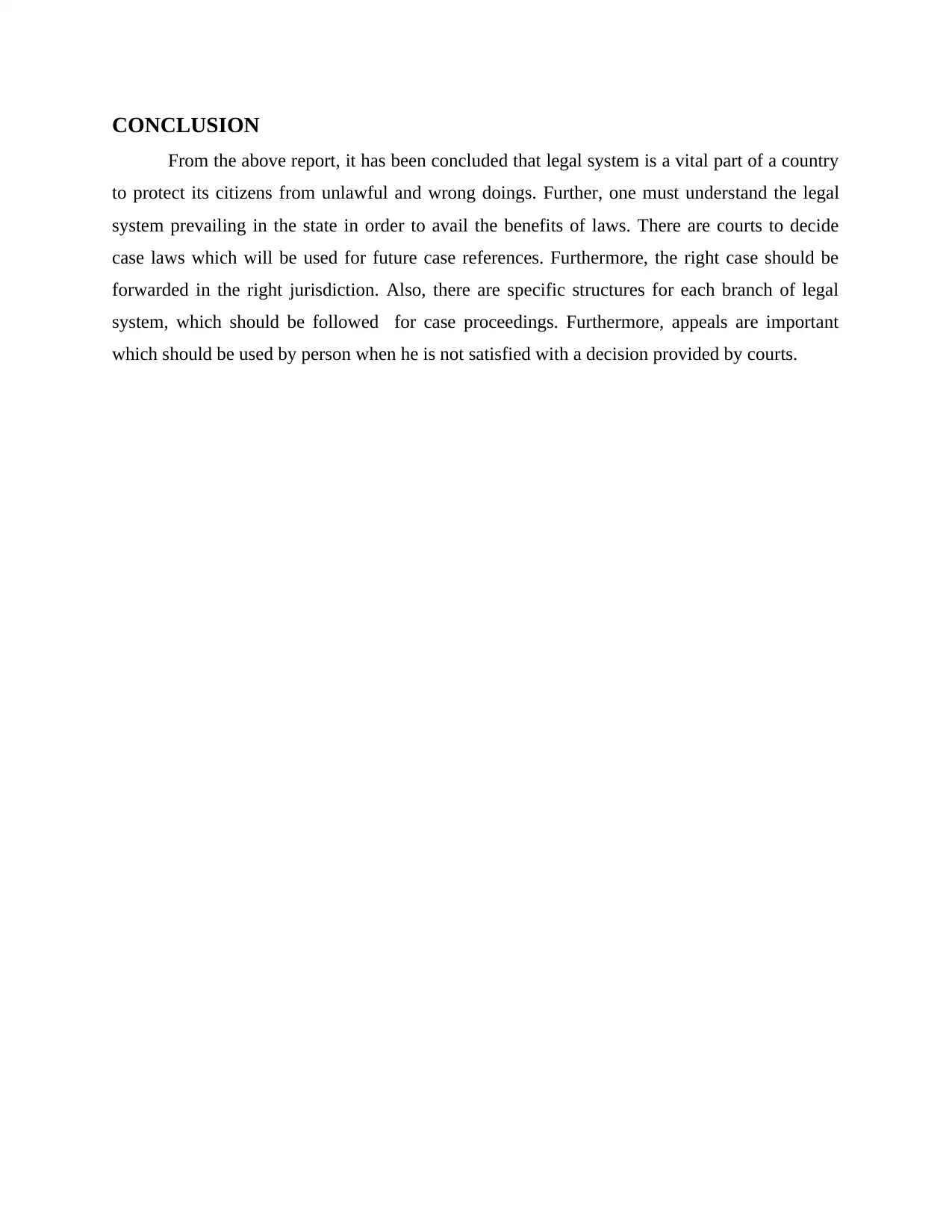
CONCLUSION
From the above report, it has been concluded that legal system is a vital part of a country
to protect its citizens from unlawful and wrong doings. Further, one must understand the legal
system prevailing in the state in order to avail the benefits of laws. There are courts to decide
case laws which will be used for future case references. Furthermore, the right case should be
forwarded in the right jurisdiction. Also, there are specific structures for each branch of legal
system, which should be followed for case proceedings. Furthermore, appeals are important
which should be used by person when he is not satisfied with a decision provided by courts.
From the above report, it has been concluded that legal system is a vital part of a country
to protect its citizens from unlawful and wrong doings. Further, one must understand the legal
system prevailing in the state in order to avail the benefits of laws. There are courts to decide
case laws which will be used for future case references. Furthermore, the right case should be
forwarded in the right jurisdiction. Also, there are specific structures for each branch of legal
system, which should be followed for case proceedings. Furthermore, appeals are important
which should be used by person when he is not satisfied with a decision provided by courts.
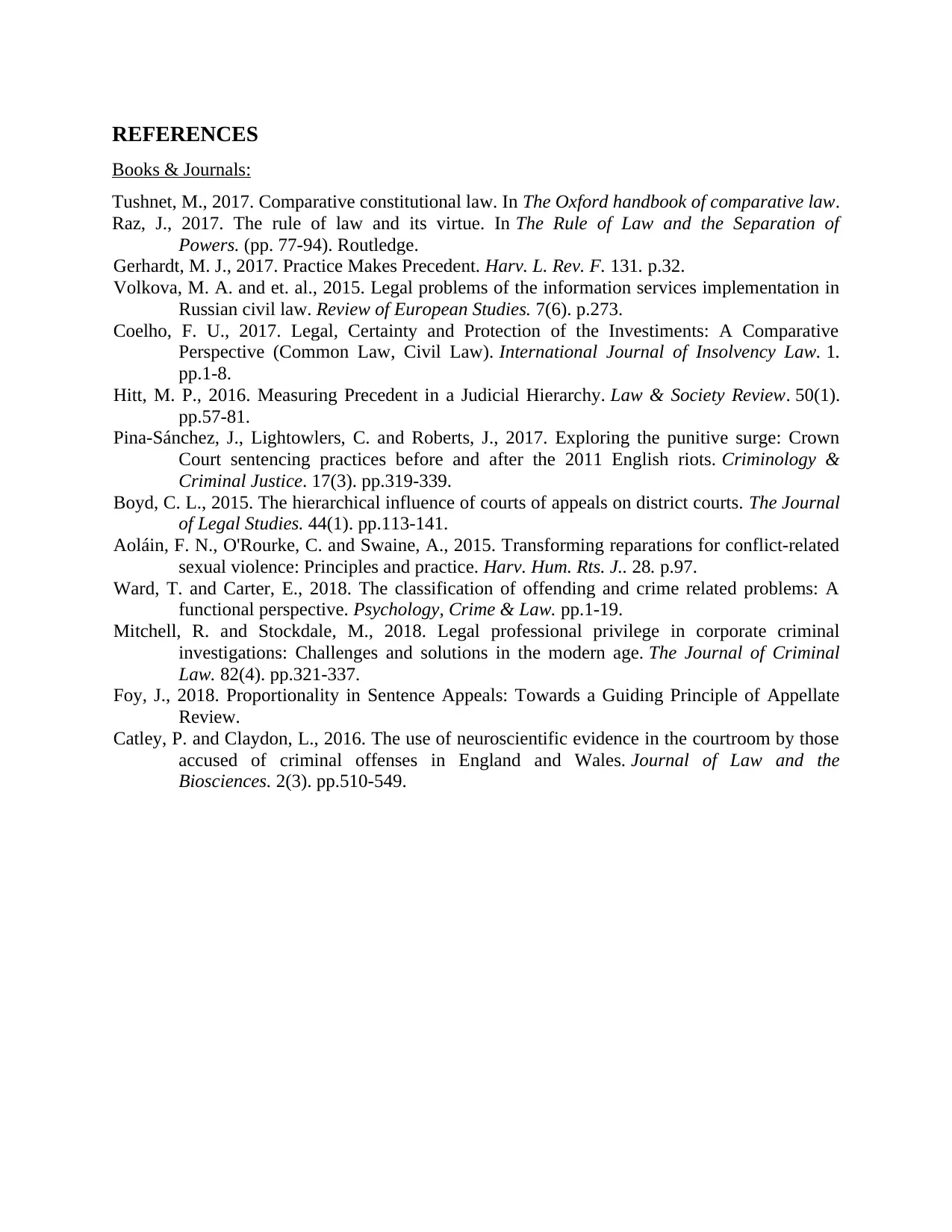
REFERENCES
Books & Journals:
Tushnet, M., 2017. Comparative constitutional law. In The Oxford handbook of comparative law.
Raz, J., 2017. The rule of law and its virtue. In The Rule of Law and the Separation of
Powers. (pp. 77-94). Routledge.
Gerhardt, M. J., 2017. Practice Makes Precedent. Harv. L. Rev. F. 131. p.32.
Volkova, M. A. and et. al., 2015. Legal problems of the information services implementation in
Russian civil law. Review of European Studies. 7(6). p.273.
Coelho, F. U., 2017. Legal, Certainty and Protection of the Investiments: A Comparative
Perspective (Common Law, Civil Law). International Journal of Insolvency Law. 1.
pp.1-8.
Hitt, M. P., 2016. Measuring Precedent in a Judicial Hierarchy. Law & Society Review. 50(1).
pp.57-81.
Pina-Sánchez, J., Lightowlers, C. and Roberts, J., 2017. Exploring the punitive surge: Crown
Court sentencing practices before and after the 2011 English riots. Criminology &
Criminal Justice. 17(3). pp.319-339.
Boyd, C. L., 2015. The hierarchical influence of courts of appeals on district courts. The Journal
of Legal Studies. 44(1). pp.113-141.
Aoláin, F. N., O'Rourke, C. and Swaine, A., 2015. Transforming reparations for conflict-related
sexual violence: Principles and practice. Harv. Hum. Rts. J.. 28. p.97.
Ward, T. and Carter, E., 2018. The classification of offending and crime related problems: A
functional perspective. Psychology, Crime & Law. pp.1-19.
Mitchell, R. and Stockdale, M., 2018. Legal professional privilege in corporate criminal
investigations: Challenges and solutions in the modern age. The Journal of Criminal
Law. 82(4). pp.321-337.
Foy, J., 2018. Proportionality in Sentence Appeals: Towards a Guiding Principle of Appellate
Review.
Catley, P. and Claydon, L., 2016. The use of neuroscientific evidence in the courtroom by those
accused of criminal offenses in England and Wales. Journal of Law and the
Biosciences. 2(3). pp.510-549.
Books & Journals:
Tushnet, M., 2017. Comparative constitutional law. In The Oxford handbook of comparative law.
Raz, J., 2017. The rule of law and its virtue. In The Rule of Law and the Separation of
Powers. (pp. 77-94). Routledge.
Gerhardt, M. J., 2017. Practice Makes Precedent. Harv. L. Rev. F. 131. p.32.
Volkova, M. A. and et. al., 2015. Legal problems of the information services implementation in
Russian civil law. Review of European Studies. 7(6). p.273.
Coelho, F. U., 2017. Legal, Certainty and Protection of the Investiments: A Comparative
Perspective (Common Law, Civil Law). International Journal of Insolvency Law. 1.
pp.1-8.
Hitt, M. P., 2016. Measuring Precedent in a Judicial Hierarchy. Law & Society Review. 50(1).
pp.57-81.
Pina-Sánchez, J., Lightowlers, C. and Roberts, J., 2017. Exploring the punitive surge: Crown
Court sentencing practices before and after the 2011 English riots. Criminology &
Criminal Justice. 17(3). pp.319-339.
Boyd, C. L., 2015. The hierarchical influence of courts of appeals on district courts. The Journal
of Legal Studies. 44(1). pp.113-141.
Aoláin, F. N., O'Rourke, C. and Swaine, A., 2015. Transforming reparations for conflict-related
sexual violence: Principles and practice. Harv. Hum. Rts. J.. 28. p.97.
Ward, T. and Carter, E., 2018. The classification of offending and crime related problems: A
functional perspective. Psychology, Crime & Law. pp.1-19.
Mitchell, R. and Stockdale, M., 2018. Legal professional privilege in corporate criminal
investigations: Challenges and solutions in the modern age. The Journal of Criminal
Law. 82(4). pp.321-337.
Foy, J., 2018. Proportionality in Sentence Appeals: Towards a Guiding Principle of Appellate
Review.
Catley, P. and Claydon, L., 2016. The use of neuroscientific evidence in the courtroom by those
accused of criminal offenses in England and Wales. Journal of Law and the
Biosciences. 2(3). pp.510-549.
1 out of 12
Related Documents
Your All-in-One AI-Powered Toolkit for Academic Success.
+13062052269
info@desklib.com
Available 24*7 on WhatsApp / Email
![[object Object]](/_next/static/media/star-bottom.7253800d.svg)
Unlock your academic potential
© 2024 | Zucol Services PVT LTD | All rights reserved.





